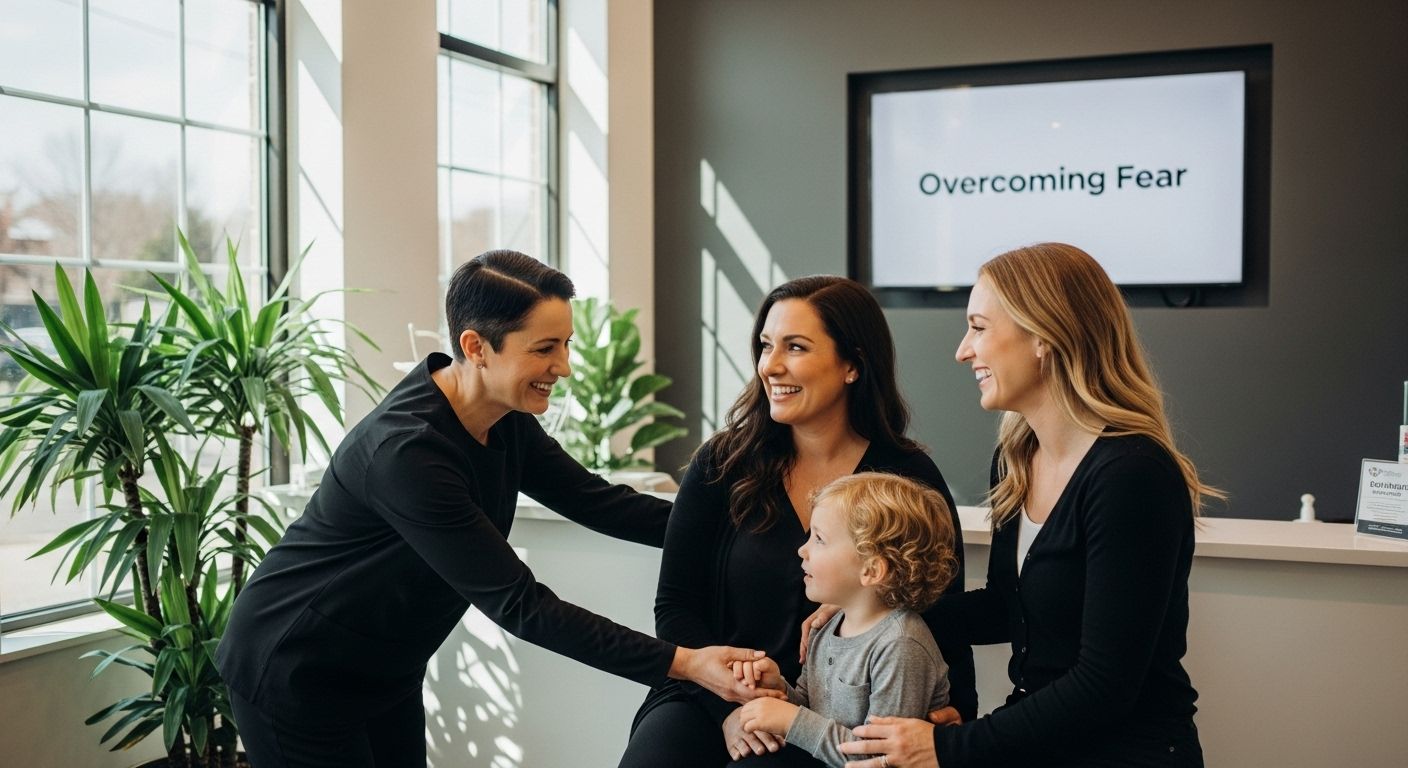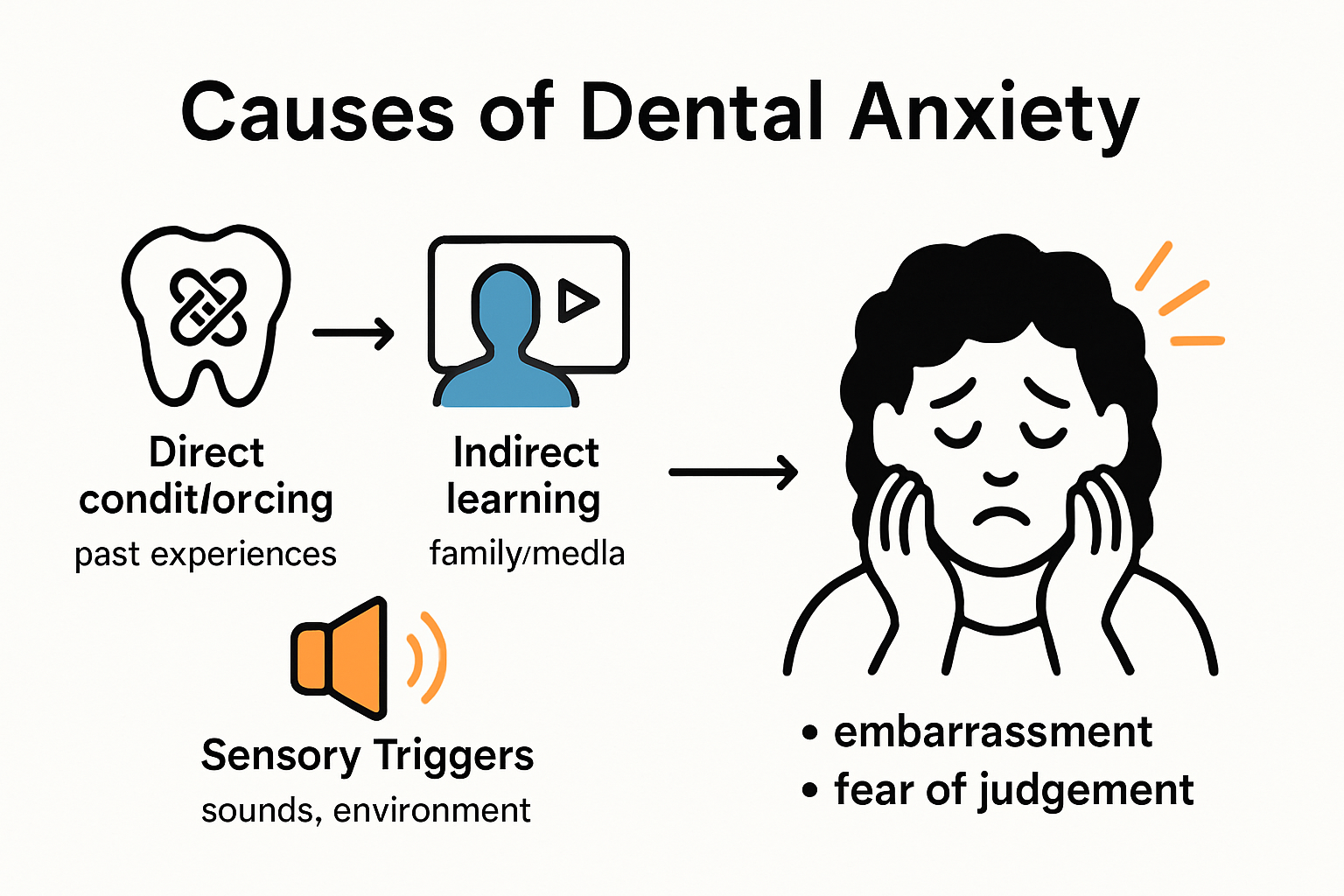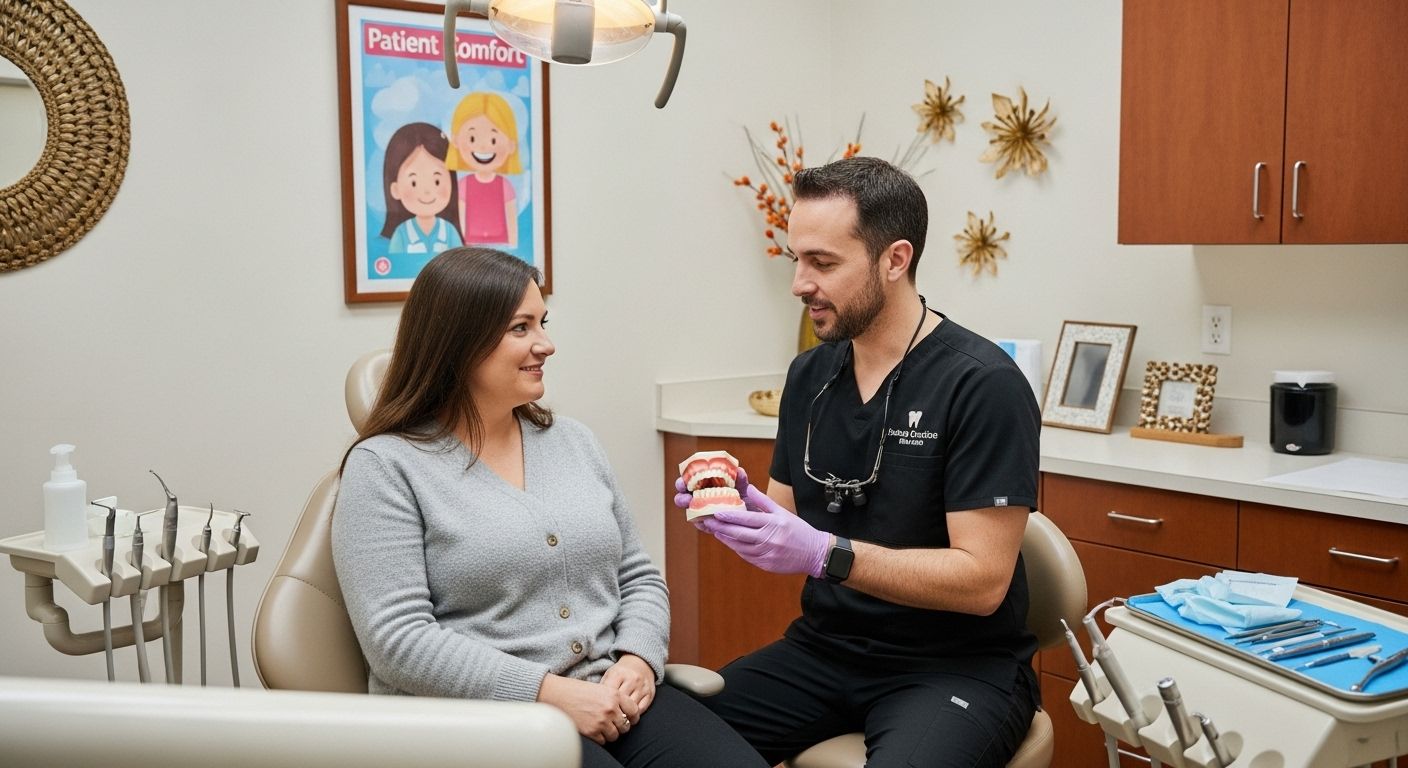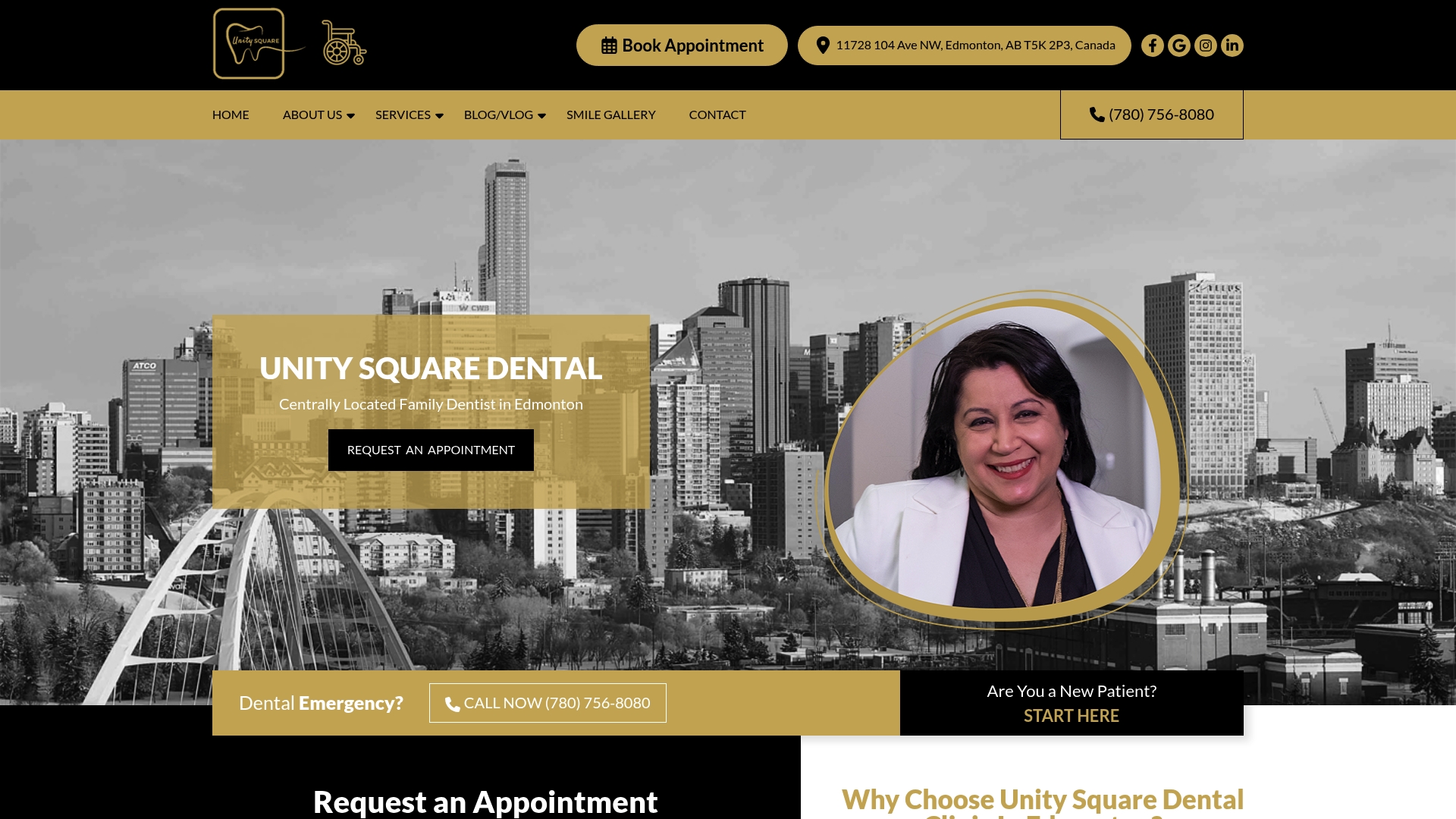
Nearly 36 percent of people experience some level of dental anxiety, turning even a regular checkup into a stressful ordeal. Most expect the pain to be the worst part and brace themselves for needles and drilling sounds. But the real surprise is that fear alone can keep people from getting basic dental care, leading to much bigger health problems down the road. The right strategies and an understanding team can break that cycle, making every visit easier than you ever thought possible.
Table of Contents
- Why People Fear Going to the Dentist
- Proven Techniques for Easing Dental Anxiety
- How Edmonton Dentists Create a Comfortable Experience
- Accessible Dental Care for Every Need
Quick Summary
| Takeaway | Explanation |
|---|---|
| Understand the roots of dental anxiety. | Recognizing psychological and sensory triggers can help address fear before dentist visits. |
| Practice relaxation and mindfulness techniques. | Techniques like deep breathing and visualization can calm nerves during dental procedures. |
| Communicate openly with dental professionals. | Sharing specific fears enables dentists to tailor care and alleviate anxiety. |
| Utilize comfort and distraction methods. | Personal items, music, or advanced technologies can provide significant emotional support during visits. |
| Seek patient-centered care strategies. | Many dental practices focus on creating a welcoming environment and using advanced technology to improve comfort. |
Why People Fear Going to the Dentist
Dental anxiety is a complex psychological experience that affects millions of people worldwide, transforming routine dental visits into sources of intense emotional distress. Understanding the root causes of this fear can be the first step in overcoming it and ensuring better oral health.
To help readers understand the different sources of dental anxiety, the following table summarizes the origins and common triggers as outlined in the section.
| Source of Dental Anxiety | Description |
|---|---|
| Direct Conditioning | Traumatic or painful dental experiences leading to lasting psychological effects |
| Indirect Learning | Internalizing fear from family, media, or secondhand negative stories |
| Sensory Triggers | Anxiety from clinical environment, equipment sounds, needles, and unfamiliar sensations |
| Vulnerability and Exposure | Feeling exposed, vulnerable, or unable to communicate during procedures |
| Emotional Complexity | Embarrassment, fear of judgment or diagnoses, and potential avoidance of dental visits |
Psychological Origins of Dental Anxiety
Research published in the National Institutes of Health reveals that dental fear typically stems from multiple interconnected sources. Direct conditioning plays a significant role, where previous traumatic or painful dental experiences create lasting psychological imprints. Patients who have encountered uncomfortable or distressing procedures are more likely to develop a deep-seated fear of dental environments.
Indirect learning also contributes substantially to dental anxiety. People often internalize fear through family narratives, media representations, and secondhand accounts of negative dental experiences. A child who hears repeated stories about painful dental treatments from parents or siblings may develop anticipatory anxiety before ever sitting in a dental chair.
Sensory and Vulnerability Triggers
The dental environment itself can trigger intense anxiety. The clinical setting, with its sterile atmosphere, unfamiliar sounds of dental equipment, and potential perceived threats like needles and drilling tools, can overwhelm sensory perceptions. Many individuals report feeling vulnerable and exposed during dental examinations, which intensifies their emotional discomfort.
Sensory triggers such as the high-pitched whirring of dental tools, the cold metallic instruments, and the close physical proximity to a healthcare professional can provoke significant stress responses. For some patients, the loss of control and inability to communicate during procedures amplifies their underlying fears.
Complex Emotional Landscape
Beyond immediate sensory experiences, dental anxiety often intertwines with deeper emotional complexities. Feelings of embarrassment about oral health, fear of potential judgment from dental professionals, and concerns about potential painful diagnoses can compound existing anxieties.
Some individuals develop such intense fear that they avoid dental visits entirely, leading to deteriorating oral health and creating a harmful cycle of neglect and increased medical complexity. This avoidance behavior can result in more invasive and potentially painful treatments that might have been preventable through regular check-ups.

Recognizing these multifaceted psychological dynamics is crucial. By understanding that dental fear is a legitimate and common experience, patients can begin to develop strategies for managing their anxiety. Learn more about our compassionate approach to patient care that prioritizes emotional comfort alongside dental health.
Overcoming dental fear requires patience, understanding, and personalized strategies that address individual psychological and sensory triggers. Professional dental practices increasingly recognize the importance of creating supportive, non-threatening environments that help patients feel safe and respected throughout their dental journey.
Proven Techniques for Easing Dental Anxiety
Dental anxiety can be overwhelming, but numerous scientifically backed strategies can help patients transform their dental experience from a source of stress to a manageable and even comfortable interaction. By understanding and implementing specific techniques, individuals can significantly reduce their fear and approach dental visits with greater confidence.
This table summarizes various techniques and methods for managing dental anxiety, organizing them by approach and providing examples from the article.
| Approach | Examples / Techniques |
|---|---|
| Relaxation & Mindfulness | Deep breathing, guided imagery, visualization |
| Communication & Cognitive Strategies | Open dialogue with dental professionals, cognitive behavioral techniques |
| Practical Comfort & Distraction | Noise-canceling headphones, music, audiobooks, bringing a trusted friend |
| Technological & Sedation Interventions | Mild sedation, virtual reality distraction, advanced topical anesthetics |
Relaxation and Mindfulness Techniques
Harvard Health recommends several evidence-based relaxation methods for managing dental anxiety. Deep breathing exercises stand out as a powerful tool for calming the nervous system. By practicing slow, deliberate breaths that engage the diaphragm, patients can activate their body’s natural relaxation response, reducing heart rate and decreasing physiological stress markers.
Guided imagery and visualization techniques offer another effective approach. Patients can mentally transport themselves to a peaceful environment, such as a calm beach or serene forest, while in the dental chair. This mental distraction helps interrupt anxiety cycles and provides a sense of psychological control during dental procedures.
Communication and Cognitive Strategies
Research from the National Institutes of Health highlights the importance of proactive communication in managing dental anxiety. Establishing a clear, open dialogue with dental professionals about specific fears allows for personalized anxiety management strategies. Many dental practices now offer preliminary consultations designed specifically to address patient concerns and build trust.
Cognitive behavioral techniques can also help reframe negative thought patterns associated with dental visits. By working with a therapist or trained dental professional, patients can develop coping mechanisms that transform fear-based thoughts into more rational, manageable perspectives. This might involve breaking down procedural steps, understanding medical processes, and challenging irrational beliefs about potential pain or discomfort.
Practical Comfort and Distraction Methods
The American Dental Association suggests practical strategies that can make dental visits more comfortable. Bringing personal comfort items like noise-canceling headphones, a favorite playlist, or even a trusted friend can provide significant emotional support. Some patients find great relief in using audiobooks, podcasts, or music to create a mental buffer during procedures.
Additionally, discover our compassionate approach to patient comfort that prioritizes individual needs and emotional well-being. Modern dental practices increasingly recognize that patient comfort extends beyond physical treatment and encompasses psychological support.
Technology and sedation options have also expanded to support patients with severe dental anxiety. Techniques like mild sedation, virtual reality distraction, and progressive relaxation methods offer innovative solutions for those struggling with intense fear. By combining these approaches, patients can gradually build confidence and transform their dental experience from a source of dread to a routine health maintenance activity.
How Edmonton Dentists Create a Comfortable Experience
Modern dental practices understand that patient comfort extends far beyond clinical procedures. Creating a welcoming, supportive environment requires a comprehensive approach that addresses both physical and psychological aspects of patient care. Edmonton dentists have developed sophisticated strategies to transform traditional dental experiences into positive, stress-reducing interactions.
Patient-Centered Communication Strategies
Research in Health Affairs highlights the critical importance of effective communication in reducing patient anxiety. Dental professionals now prioritize transparent, empathetic dialogues that establish trust from the first interaction. This involves actively listening to patient concerns, explaining procedures in clear, non-technical language, and providing comprehensive information that demystifies dental treatments.
Pre-procedure consultations have become a standard practice, allowing patients to discuss their specific fears and develop personalized comfort plans. Dentists take time to understand individual anxiety triggers, creating tailored approaches that might include specific positioning, frequent breaks, or specialized communication techniques that help patients feel more in control.
Environmental Design and Sensory Management
Clinical research reveals that environmental factors significantly impact patient comfort. Modern dental practices in Edmonton are redesigning their spaces to minimize clinical intimidation. This includes using calming color palettes, providing comfortable seating, incorporating natural lighting, and creating waiting areas that feel more like welcoming lounges than sterile medical environments.
Sensory management plays a crucial role in reducing anxiety. Many dental offices now offer noise-canceling headphones, television screens for distraction, and even aromatherapy options to create a more relaxing atmosphere. Specialized techniques like soft background music, temperature-controlled rooms, and gentle lighting help patients feel more at ease during procedures.
Advanced Comfort and Technological Interventions
Behavioral research demonstrates the effectiveness of technological interventions in managing dental anxiety. Edmonton dentists are adopting innovative approaches such as virtual reality distraction techniques, which allow patients to mentally escape the dental environment during procedures. Some practices offer tablet devices with entertainment options, enabling patients to watch movies or listen to podcasts during treatments.
Additionally, explore our comprehensive approach to patient comfort that integrates cutting-edge technology with compassionate care. Sedation options have also evolved, providing graduated levels of relaxation from mild oral sedatives to more comprehensive approaches for patients with extreme anxiety.
Pharmaceutical advancements and precise numbing techniques have made dental procedures significantly more comfortable. Dentists now use advanced topical anesthetics and refined injection techniques that minimize discomfort. Some practices even offer preliminary consultations focused entirely on anxiety management, demonstrating a holistic approach to patient care.
The goal of modern dental practices is to transform dental visits from potentially stressful experiences into manageable, even positive healthcare interactions. By combining technological innovation, compassionate communication, and patient-centered design, Edmonton dentists are redefining what it means to receive dental care in the 21st century.

Accessible Dental Care for Every Need
Accessible dental care represents more than just physical entry to a dental clinic. It encompasses a holistic approach that considers diverse patient needs, addressing physical, emotional, and psychological barriers that might prevent individuals from receiving essential oral healthcare services.
Comprehensive Patient Accommodation
Research published in the Special Care in Dentistry journal highlights that dental fear and anxiety significantly impact healthcare accessibility, particularly for patients with special health care requirements. Modern dental practices are developing innovative strategies to create inclusive environments that welcome patients of all abilities, backgrounds, and comfort levels.
Physical accessibility remains a critical component. This includes wheelchair-friendly facilities, adjustable examination chairs, spacious treatment rooms, and equipment designed to accommodate patients with mobility challenges. Dental offices are increasingly recognizing that true accessibility extends beyond architectural considerations to encompass comprehensive patient support.
Personalized Care Strategies
The Australian Dental Journal emphasizes non-pharmacological techniques like cognitive-behavioral therapy and systematic desensitization as crucial methods for managing patient anxiety. These approaches allow dental professionals to develop individualized care plans that address specific patient concerns, creating a more comfortable and supportive healthcare experience.
Specialized communication techniques play a vital role in accessible dental care. This includes offering multilingual support, providing clear explanations using simple language, and employing patient advocates or support personnel who can help individuals navigate their dental health journey. Some practices offer preliminary consultations specifically designed to understand and mitigate patient anxieties.
Technological and Supportive Interventions
The National Institute of Dental and Craniofacial Research underscores the importance of developing innovative interventions that prevent dental fear and improve overall care accessibility. Modern dental practices are incorporating advanced technologies and supportive methods to create more welcoming environments.
These interventions include virtual reality distraction techniques, advanced sedation options, pain management strategies, and flexible scheduling that accommodates diverse work and life commitments. Learn more about our compassionate approach to family dental care that prioritizes individual needs and comfort.
Technological advancements like digital scanning, minimally invasive procedures, and precision instruments have made dental treatments less intimidating. Practices are also offering extended hours, weekend appointments, and flexible payment plans to remove traditional barriers to dental care.
Ultimately, accessible dental care is about creating an environment of trust, understanding, and personalized support. By recognizing and addressing the unique needs of each patient, dental practices can transform healthcare experiences from potentially stressful encounters to supportive, empowering interactions that prioritize both physical and emotional well-being.
Frequently Asked Questions
What causes dental anxiety?
Dental anxiety can stem from various factors, including previous traumatic experiences, sensory triggers like sounds and smells, and feelings of vulnerability during dental procedures.
How can I manage my fear of visiting the dentist?
You can manage dental fear by practicing relaxation techniques such as deep breathing, communicating openly with your dentist about your fears, and using distraction methods such as music or audiobooks during your appointment.
Are there specific techniques to calm anxiety before a dental visit?
Yes, techniques like visualization, guided imagery, and cognitive behavioral strategies can help calm your nerves before a dental visit. Discussing your anxiety with your dentist can also lead to personalized comfort strategies.
What should I expect from dentists who specialize in anxiety management?
Dentists who specialize in anxiety management often prioritize patient-centered communication, provide a welcoming environment, and use advanced comfort technologies, such as virtual reality or sedation options, to make dental visits less stressful.
Take Back Control of Your Dental Visits—Experience Comfort at Unity Square Dental
If fear of the dentist has kept you from enjoying a healthy smile, you are not alone. Many people struggle with anxiety triggered by clinical sounds, loss of control, or past negative experiences. Our article addresses these real emotional challenges and highlights proven strategies to help you manage dental anxiety. Unity Square Dental turns these strategies into real solutions with patient-first care, comfort technology, and a friendly team that truly listens.

Why wait to put your fears behind you? Visit Unity Square Dental and see how our compassionate approach, relaxing environment, and flexible scheduling—including weekends—support stress-free visits. From general dentistry to advanced comfort options like sedation, we make every step about your ease and safety. Take the first step to a more confident dental experience. Book your appointment today and let us help you conquer dental fear for good.
Recommended
- Stress and Dental Health: Essential Guide for Edmonton Families 2025 – Unity Square Dental
- Understanding the Importance of Dental Cleanings in Edmonton: 2025 Guide – Unity Square Dental
- Dental Care for Families in Edmonton: Your 2025 Guide – Unity Square Dental
- How to Find a New Dentist in Edmonton: Tips for 2025 – Unity Square Dental
- The Ultimate Guide to Finding the Best Dentist in Blacktown for Your Oral Health Needs – Paynless Dental Clinic

